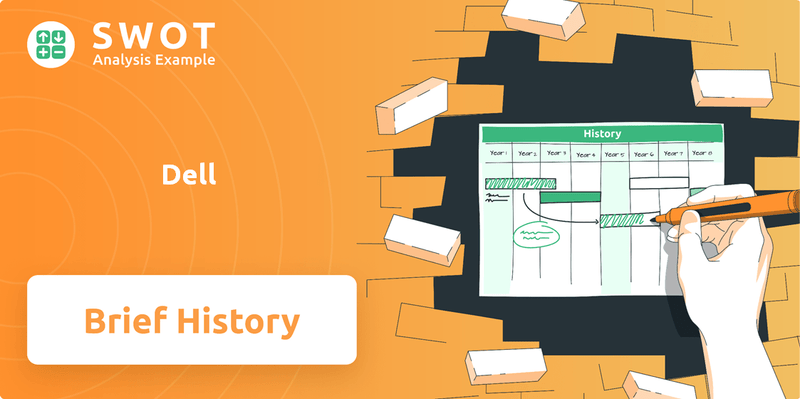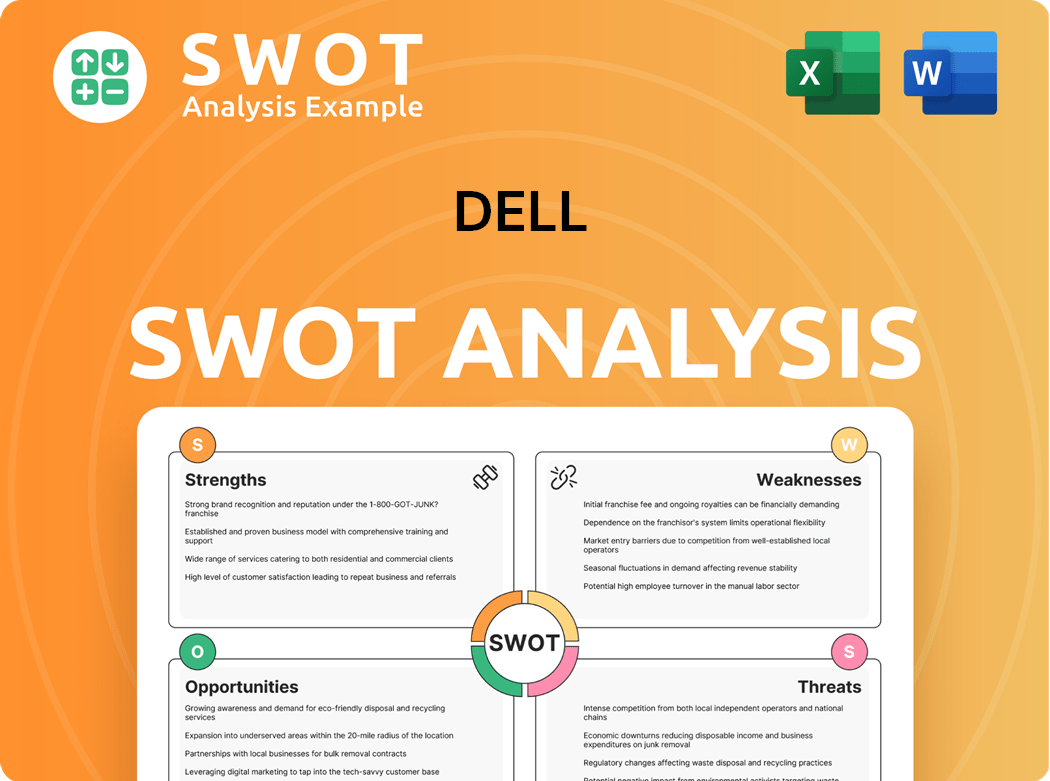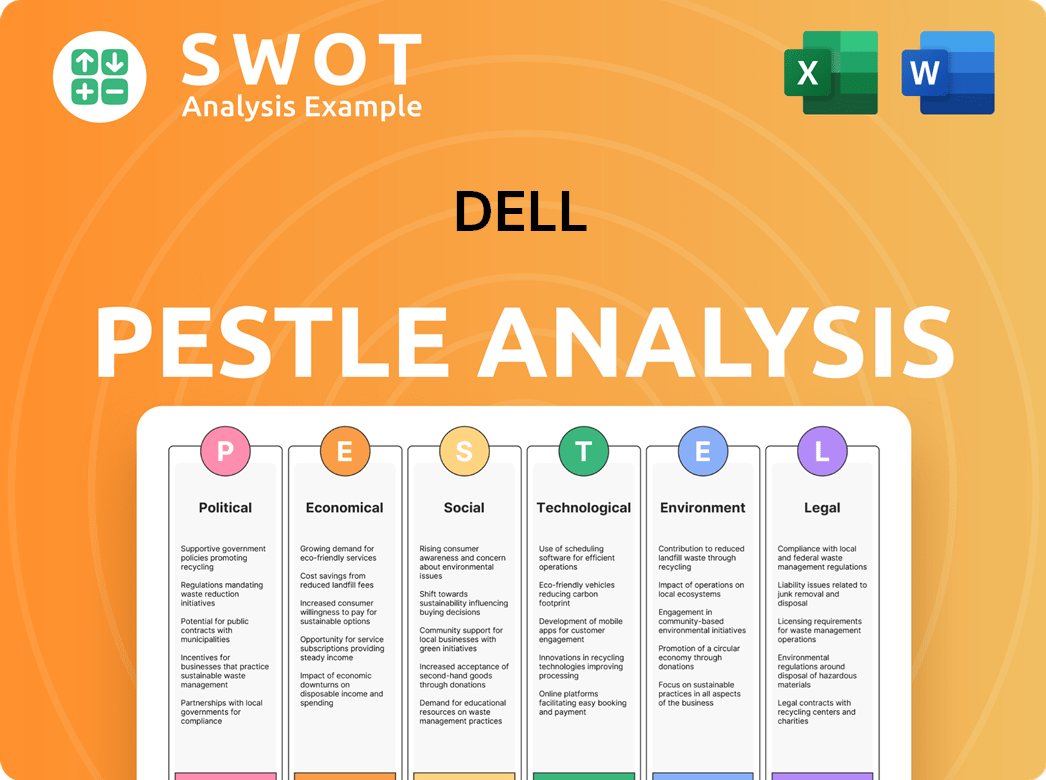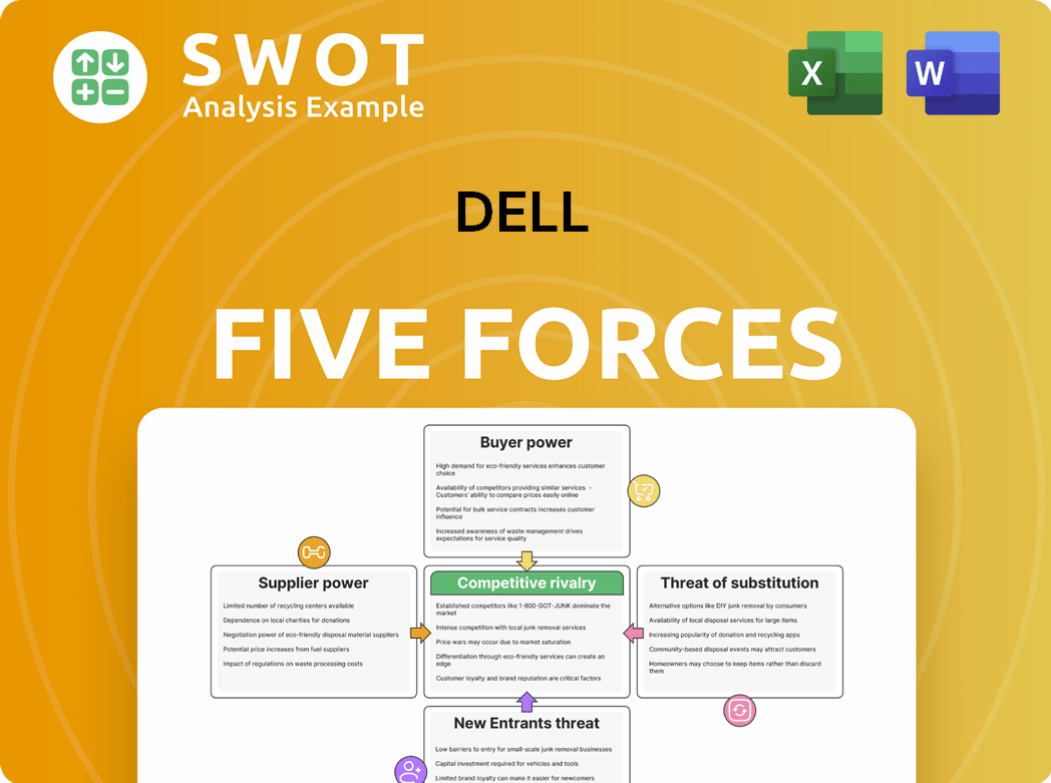Dell Bundle
How did a college dorm room spark a tech revolution for Dell?
From a dorm room startup to a global tech giant, the Dell SWOT Analysis reveals a fascinating story of innovation and adaptation. This is the brief history of Dell, a company that disrupted the PC industry with its direct-to-consumer model. Discover how Michael Dell's vision transformed the way computers were sold and shaped the technology landscape.

The Dell company's origin story began in 1984 when Michael Dell, a young entrepreneur, saw an opportunity to revolutionize the PC manufacturer market. Dell's early days were marked by a commitment to customer customization and value, a strategy that quickly set it apart. Exploring the Dell timeline reveals key milestones, including its impact on the PC industry and its evolution over time, solidifying its position as a technology leader.
What is the Dell Founding Story?
The story of the Dell company began in 1984, a tale of innovation and direct customer engagement. Founded by Michael Dell, the company, initially named PC's Limited, emerged from a college dorm room, challenging the established norms of the personal computer market. This marked the beginning of what would become a global technology leader.
Michael Dell's vision was simple yet revolutionary: to bypass traditional retail channels and sell computers directly to customers. This approach allowed for customization, competitive pricing, and a deeper understanding of customer needs. The early success of this model laid the foundation for the company's future growth.
The company's journey, from its humble beginnings to its current status, is a testament to its adaptability and commitment to innovation. The Target Market of Dell has evolved significantly, but its core principles of customer focus and direct sales have remained constant.
Michael Dell founded the company in 1984 while a student at the University of Texas at Austin, starting with just $1,000.
- Initially named PC's Limited, the company built and sold IBM PC-compatible computers directly to consumers.
- The first in-house designed computer, the 'Turbo PC,' was launched in 1985, priced at $795.
- The company's name officially changed to Dell Computer Corporation in 1988.
- Dell's early success was built on a direct sales model, allowing for customization and competitive pricing.
Michael Dell, a nineteen-year-old freshman, launched PC's Limited from his dorm room. His early interest in technology, including a mail-order stamp-trading business, provided a foundation for his entrepreneurial venture. The initial challenge was the inefficiency and cost of traditional computer sales. Dell's direct-to-customer model aimed to solve this by better understanding customer needs and offering competitive pricing.
The business model revolved around building IBM PC-compatible computers from stock components. These were then sold directly to consumers via phone orders. Delivery typically took between two to three weeks. The 'Turbo PC,' launched in 1985, was the first in-house designed computer, priced at $795. The initial funding of $1,000 came from Michael Dell. He had to build more computers to raise the money for incorporation.
The initial name, PC's Limited, was deemed too generic by a lawyer. The business was incorporated as 'Dell Computer Corporation, Doing Business As PCs Limited.' The name officially changed to Dell Computer Corporation in 1988, coinciding with the company's initial public offering. This bootstrapping approach and the direct sales model were crucial for establishing the company in the personal computer market of the 1980s.
Dell SWOT Analysis
- Complete SWOT Breakdown
- Fully Customizable
- Editable in Excel & Word
- Professional Formatting
- Investor-Ready Format

What Drove the Early Growth of Dell?
The early growth of the company, a significant chapter in the Dell history, was marked by rapid expansion. This growth was fueled by its innovative direct-to-consumer model, which quickly gained traction in the market. The company's evolution over time showcases its adaptability and strategic foresight in the competitive tech industry.
By the end of its first full year, PC's Limited generated an impressive $73 million in revenue. In 1987, the company rebranded as the Dell Computer Corporation. This rebranding was a pivotal moment in the Dell company origin story, signaling its ambition and expansion plans. The company also launched its first international subsidiary in the UK during this period.
The company differentiated itself by offering next-day on-site service and unlimited telephone technical support. This focus on customer satisfaction helped build brand loyalty. In 1988, the company went public, raising $30 million in its initial public offering, which brought the company's market capitalization to $85 million.
By 1993, the Dell company was listed among the Fortune 500, with fourteen international subsidiaries. The company employed over 4,800 workers and generated over $2 billion in sales. This made Dell the world's fourth-largest PC manufacturer. By 1995, the company expanded its worldwide operations to Europe, Asia, Japan, and the Americas.
By 1998, Dell solidified its internet leadership with $12 million in sales per day. The company established web-based connections with its suppliers. In the early 2000s, Dell continued its aggressive expansion. By 2001, it had become the world's largest PC manufacturer.
In 2002, the company diversified its product line to include televisions, handhelds, digital audio players, and printers. A significant strategic shift occurred in 2009 when Dell acquired Perot Systems for nearly $4 billion. This move marked its entry into the IT services market.
In 2013, under Michael Dell's leadership, the company went private in a $24.4 billion leveraged buyout. This move allowed the company to focus on innovation and long-term investments. This period of early growth and expansion was characterized by the company's continuous adaptation to market demands.
Dell PESTLE Analysis
- Covers All 6 PESTLE Categories
- No Research Needed – Save Hours of Work
- Built by Experts, Trusted by Consultants
- Instant Download, Ready to Use
- 100% Editable, Fully Customizable

What are the key Milestones in Dell history?
The Dell company has a rich history, marked by significant achievements and strategic shifts. From its inception, the company has evolved from a direct-to-consumer PC manufacturer to a global technology solutions provider, adapting to market changes and technological advancements.
| Year | Milestone |
|---|---|
| Early 1984 | Founded by Michael Dell, the company started with the vision of selling computers directly to consumers. |
| 2001 | Dell became the world's largest PC manufacturer, a significant achievement in the early days of Dell. |
| 2009 | Dell entered the IT services market with the acquisition of Perot Systems. |
| 2016 | Dell merged with EMC Corporation in a $67 billion deal, forming Dell Technologies. |
| 2021 | Dell launched Dell Apex, its 'anything as a service' (XaaS) portfolio, focusing on subscription-based models. |
Dell's innovations have been pivotal in shaping the PC industry. The direct-to-consumer sales model was a groundbreaking move, allowing for customized PCs and competitive pricing, which set the company apart. Furthermore, the company's strategic acquisitions and expansions into IT services and cloud infrastructure demonstrate its commitment to innovation and staying ahead of market trends.
This model allowed for customized PCs and competitive pricing, which was a key differentiator in its early growth. This approach bypassed traditional retail channels, enabling direct interaction with customers.
Dell offered customers the ability to configure their computers to meet specific needs. This level of customization was innovative at the time and appealed to a wide range of users.
The acquisition of Perot Systems marked a strategic shift towards IT services. This move broadened the company's offerings and customer base.
This merger significantly expanded Dell's market reach and strengthened its position in enterprise solutions. It created a powerhouse in the technology industry.
Dell Apex, its 'anything as a service' (XaaS) portfolio, covering cloud, storage, and infrastructure, showcasing its move towards a subscription-based model. This demonstrates the company's adaptation to the evolving needs of its customers.
Dell has focused on AI innovation, with its AI-optimized servers seeing significant demand. The company's AI business grew to $10 billion for FY2025, with AI orders demand at $1.7 billion in Q4 and shipments of $2.1 billion, and an AI backlog of roughly $9 billion.
Despite its successes, the company has faced several challenges. In the mid-2000s, poor customer service and shipping delays damaged its reputation. The company has also had to navigate competitive threats and adapt to changing market trends.
Complaints about poor customer service and shipping delays in the mid-2000s hurt the company's reputation. This led to a need for improvements in customer relations.
A significant incident occurred in 2006 when faulty Sony-made batteries led to some Dell laptops catching fire, resulting in the recall of 4.2 million machines. This event impacted the brand's image.
In 2010, Dell paid a $100 million settlement over charges by the US Securities and Exchange Commission for falsely stating earnings. This event highlighted financial reporting concerns.
The company has faced intense competition from major technology companies like HP, Lenovo, and Apple. Staying competitive requires constant innovation and strategic adaptation.
The shift towards cloud computing, mobile devices, and AI has required Dell to adapt its business model. This has involved restructuring and strategic pivots to remain relevant.
The company, like others in the industry, has faced challenges related to global supply chain disruptions. These issues have impacted production and delivery timelines.
Dell Business Model Canvas
- Complete 9-Block Business Model Canvas
- Effortlessly Communicate Your Business Strategy
- Investor-Ready BMC Format
- 100% Editable and Customizable
- Clear and Structured Layout

What is the Timeline of Key Events for Dell?
The Revenue Streams & Business Model of Dell has evolved significantly since its inception. The Dell company journey began in 1984 when Michael Dell founded PC's Limited; it has since transformed from a small start-up into a global technology leader. This Dell history is marked by strategic shifts, innovative products, and significant acquisitions, reflecting its adaptation to the ever-changing tech landscape. The company's success is a testament to its ability to anticipate market trends and capitalize on emerging opportunities.
| Year | Key Event |
|---|---|
| 1984 | Michael Dell founded PC's Limited in his dorm room. |
| 1985 | PC's Limited launched its first in-house designed computer, the 'Turbo PC.' |
| 1987 | The company rebranded as Dell Computer Corporation and expanded internationally to the UK. |
| 1988 | Dell went public, raising $30 million in its IPO. |
| 1993 | Dell was listed among the Fortune 500. |
| 1995 | Dell expanded worldwide operations across Europe, Asia, Japan, and the Americas. |
| 1998 | Dell established internet leadership with $12 million in daily sales. |
| 2001 | Dell became the world's largest PC manufacturer. |
| 2003 | Company name changed to 'Dell Inc.' to reflect expansion beyond computers. |
| 2009 | Dell acquired Perot Systems, entering the IT services market. |
| 2013 | Michael Dell took the company private in a $24.4 billion leveraged buyout. |
| 2016 | Dell merged with EMC Corporation to form Dell Technologies, the largest tech merger in history. |
| 2018 | Dell Technologies became a publicly traded company again. |
| 2021 | Dell Technologies released Dell Apex, its 'anything as a service' portfolio. |
| 2024 | Dell Technologies reported full-year revenue of $88.4 billion. |
| 2025 | Dell shifts focus towards high-margin Infrastructure Solutions Group (ISG) and AI servers. |
Dell is heavily investing in the AI sector, especially in AI-optimized servers. The company expects AI server shipments to increase substantially. Projections indicate at least $15 billion in AI server shipments for fiscal year 2026, reflecting a strong focus on this high-growth area.
The company anticipates overall revenue growth of about 8% for fiscal year 2026. Earnings are projected to be between $101 billion and $105 billion, demonstrating confidence in future performance. Analysts predict a stock price of $131 by 2025, with some estimates reaching $150.
Dell is concentrating on high-margin areas such as the Infrastructure Solutions Group (ISG) and AI servers. The company's strategic direction is to capitalize on the growing demand for AI infrastructure. This approach is designed to provide a competitive advantage in the evolving tech market.
Dell is expanding its market presence in high-growth sectors, particularly AI-powered servers and digital transformation services. The company's AI server backlog nearly doubled to $2.9 billion exiting fiscal year 2024. As of late February 2025, Dell's AI backlog was roughly $9 billion.
Dell Porter's Five Forces Analysis
- Covers All 5 Competitive Forces in Detail
- Structured for Consultants, Students, and Founders
- 100% Editable in Microsoft Word & Excel
- Instant Digital Download – Use Immediately
- Compatible with Mac & PC – Fully Unlocked

Related Blogs
- What is Competitive Landscape of Dell Company?
- What is Growth Strategy and Future Prospects of Dell Company?
- How Does Dell Company Work?
- What is Sales and Marketing Strategy of Dell Company?
- What is Brief History of Dell Company?
- Who Owns Dell Company?
- What is Customer Demographics and Target Market of Dell Company?
Disclaimer
All information, articles, and product details provided on this website are for general informational and educational purposes only. We do not claim any ownership over, nor do we intend to infringe upon, any trademarks, copyrights, logos, brand names, or other intellectual property mentioned or depicted on this site. Such intellectual property remains the property of its respective owners, and any references here are made solely for identification or informational purposes, without implying any affiliation, endorsement, or partnership.
We make no representations or warranties, express or implied, regarding the accuracy, completeness, or suitability of any content or products presented. Nothing on this website should be construed as legal, tax, investment, financial, medical, or other professional advice. In addition, no part of this site—including articles or product references—constitutes a solicitation, recommendation, endorsement, advertisement, or offer to buy or sell any securities, franchises, or other financial instruments, particularly in jurisdictions where such activity would be unlawful.
All content is of a general nature and may not address the specific circumstances of any individual or entity. It is not a substitute for professional advice or services. Any actions you take based on the information provided here are strictly at your own risk. You accept full responsibility for any decisions or outcomes arising from your use of this website and agree to release us from any liability in connection with your use of, or reliance upon, the content or products found herein.